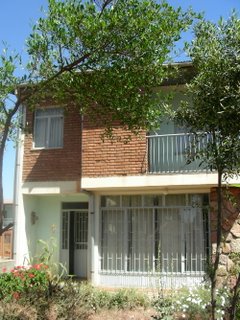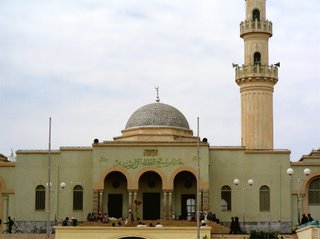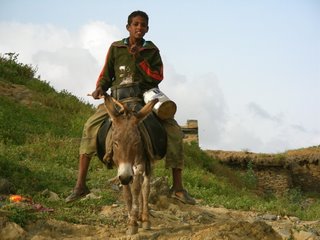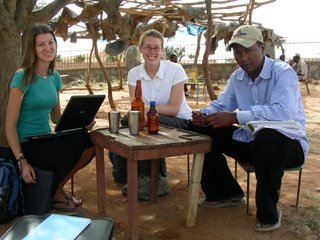 Of goats, agdus, and Leonardo Di Caprio...
Of goats, agdus, and Leonardo Di Caprio...A couple of weeks ago--I honestly can't remember when since all the days have been blending together--I traveled to western Eritrea with Anna, our paralegal, Yosief, the most senior Eritrean attorney in our office, and Simon, who can do anything. We were there to pick up evidence for our case in The Hague. Us Americans were there primarily to take witness statements.
But it was really just an adventure for me. Although we didn't see any wildlife other than insects and a lot of birds, the west is far more what I imagined Africa to be like than is Asmara. Most people live in huts with grass roofs and consider donkeys to be "vehicles." There are two kinds of huts that are common in the west: hidmos and adgus. We saw mostly agdus, which are typically round and have pointy grass roofs. Of course, sometimes they're square, as in the case of the Tabaldia town administration office below:

In Guluj, we ate breakfast at a "restaurant" constructed from tree branches, straw mats, and UNHCR plastic sheets. Don't ask me how, but they could still produce an iced cold Coke.
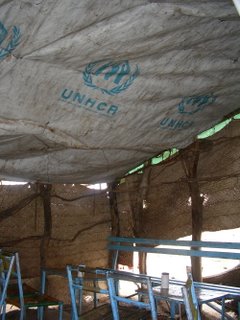
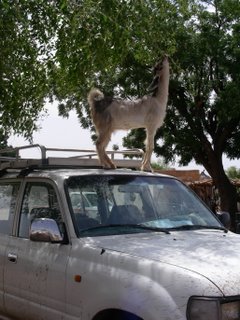
When we left the restaurant, we found a goat standing on our Land Cruiser! Goats are crazy, and they are everywhere here. Actually, goat is probably the most common meat in Eritrea. Zigni, a spicy goat stew, is always on the menu. In fact, there is a restaurant near our office in Asmara that serves a Zigni pizza.
The heat and the dust in the west are brutal. Fortunately, there were no dust storms while I was out there. Despite carrying my Camelbak around with me everywhere, I was still constantly dehydrated. The only thing that saved me was the steady flow of sugary tea. It seemed that where ever we went, people brought us tea. Some times we had to pay for it and other times it was free. But it was always at least half sugar! They actually like the sugary tea in Asmara too, but here people tend to ask you how much sugar you want before serving you.
But the most difficult thing about being out there is seeing and hearing about all the damage that was done during the war. Six years later, there is still quite a bit of rubble around. And people are really struggling to put their lives back together. But it's difficult because they have nothing, and inflation is through the roof, so many people can't afford to replace the things they had before the war. Several businesses have not been rebuilt and farms produce much less than they used to.
On a positive note, one of the more interesting parts of the trip was seeing people of multiple ethnic groups. Almost everyone in Asmara is Tigrinya, the most common ethnic group in Eritrea. But in the west and the south, we encountered people who were Kunama (the original inhabitants of Eritrea), Tigray (an ethnic group common in northern Ethiopia but also Eritrea), and Rashaida (an ethnic group decendant from Saudis who settled in Eritrea and Sudan a couple hundred years ago). The picture below is of a group of Rashaida children at their market outside of Tesseney. The Rashaidas have lived in Tesseney for 50 years, but now that there is peace in Eastern Sudan, they are returning to Sudan. There are also Rashaidas in eastern Eritrea, but they are apparently Eritrean while these Rashaidas are Sudanese.
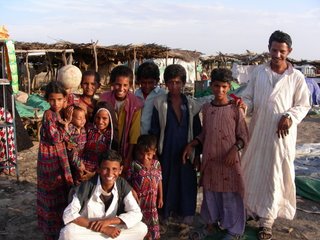
Unlike most Tigrinya children, the Rashaida children clamoured to have their photos taken. This is probably because they are more familiar with technology than are other Eritrean children. In fact, in that market you see behind them, their parents sold products such as DVD players, microwaves, and satellite dishes.
Another interesting thing about the journey was that we had to pass through a number of check points to get where ever it was that we were going. Most of these were Eritrean military checkpoints, but in the south we also went through a UN checkpoint. At two of these checkpoints, on the same day, we saw soldiers wearing T-shirts bearing giant photos of Leonardo Di Caprio under their fatigues. Anna and I could not help but laugh and really wished that we could take pictures. Unfortunately, you are not allowed to photograph military subjects here.
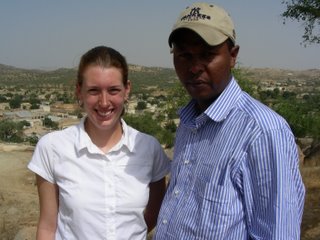
So, instead, I will leave you with a photo of me and Yosief in Barentu.
Labels: Eritrea

